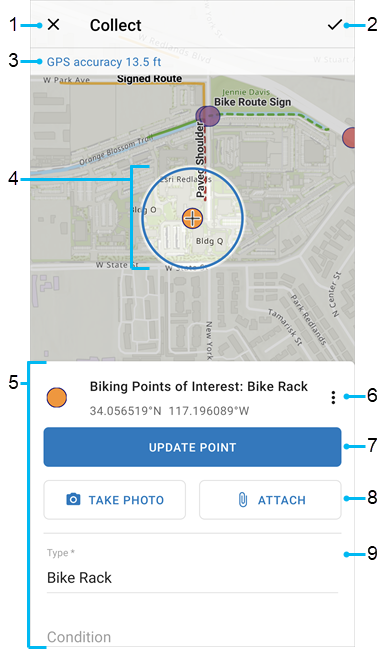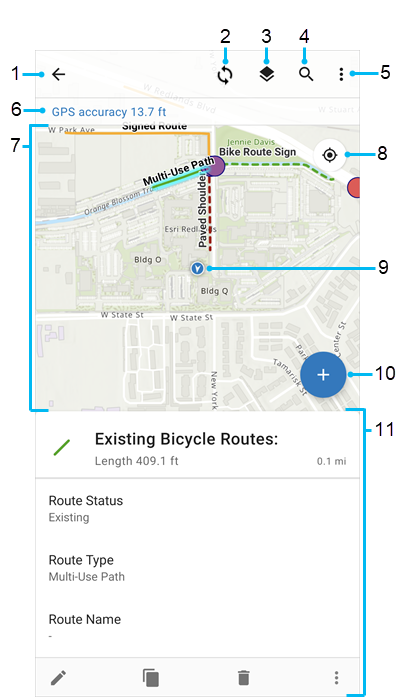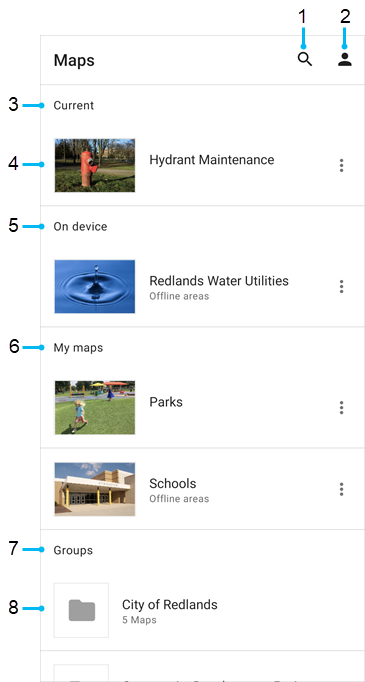Note:
The ArcGIS Collector help site is retired and no longer being updated. To learn about ArcGIS Collector retirement and to find the latest information on data collection, see Collector retirement.
When working with Collector, you can use the following:
- Data collection form and location target—Use the form and location target when capturing a new asset or observation or performing an inspection and updating an existing asset or observation.
- Map and panel—Visualize and interact with your data, including initiating data collection.
- Maps list—Find and open your maps with editable data.
Data collection form and location target
The data collection form opens when you start capturing a new asset or observation or inspecting an existing one. When filling out a form, use the location target to update the asset or observation's location. To start filling out a form and providing location, use the map and read-only form.

- Cancel—Stop capturing a new asset or observation, or discard edits made to an existing one during an inspection.
- Submit—Save the new asset or observation, or save the changes made to an existing one. If you're working online, others immediately see your edits. If you're working offline, your edits are available to others once you sync them.
- GPS banner—See information about your GPS. Tap the banner to see additional details, including the accuracy, time the position was received, and location provider.
- Location target—Where an asset or observation (or a point in the location of a length or area) will be placed on the map. It is composed of a circle and crosshairs. It displays if your layer allows updates to the location. See Capture, including the section Edit location.
If the GPS button doesn't display, the map is already centered over your location and the location target moves with you. If the GPS meets the required accuracy, the circle of the location target is blue, as is the text in the GPS banner. Otherwise, the circle and text are red. If the location target isn't centered over your location, the GPS button displays, the circle of the location target is gray, and the text in the GPS banner is gray.
Note:
The circle isn't an accuracy indicator. Use the GPS banner for accuracy information.
- Form—Fill out entries to provide information. You can expand the panel to see more of the form while filling out the entries in it. See Fill out forms.
- Overflow—Edit the location, such as undoing changes, updating and deleting points, and streaming.
- Update Point (single places)—Move the asset or observation under the location target. This displays if your layer allows updates to the location.
It is replaced by Add Point for lengths and areas, which adds a point to the asset or observation under the location target.
- Take Photo and Attach—Add photos and videos. This displays if your layer supports attachments.
- Form entry—An entry in the form where information can be provided.
- GPS button
 (not shown above)—Recenter the location target on your location. This displays when the location target isn't centered on your location.
(not shown above)—Recenter the location target on your location. This displays when the location target isn't centered on your location. 
Note:
When working with the map outside of data collection, a blue dot on the map shows your location. This is intentionally hidden during data collection: the dot obscures the area around you, which is often your area of interest.
Map and panel
Use the map to find your assets and observations and view their read-only forms in the panel, as well as to start capturing assets or observations or performing inspections. To open a map, use the Maps list.

- Back arrow—Go back to the Maps list. If you opened the map from a group or list of map areas, the arrow takes you to the group or list of map areas in the Maps list.
- Sync—If you are working in an offline map area, sync to send your changes. When the sync icon has a dot
 , you have pending edits. See Sync your work.
, you have pending edits. See Sync your work.Depending on the configuration of the map you are using, sync may get changes that were made since your download and copy them to your device. See Optimize download and sync.
- Layers—View the layers in the map, change their visibility, and see any errors.
- Search—Find addresses, places, assets, and observations. Search honors what is configured in the map. See Configure feature search in ArcGIS Online or Configure feature search in ArcGIS Enterprise. Finding addresses and places requires an internet connection. You can search assets and observations without a connection.
- Overflow—Change the basemap, go to Bookmarks, view the legend, or measure on the map.
- GPS banner—See information about your GPS. Tap the banner to see additional details, including the accuracy, time the position was received, and location provider.
- Map—View and interact with your assets and observations. Tap an asset or observation to view its form.
You can pan, zoom in and out, and rotate the map. Long press to use a magnifier and drop a pin at a location of interest or search to get result pins on the map. Tap a pin to view its details.
Tip:
If you rotate the map, the rotation angle is shown by a compass
 in the upper right corner of the map. Tap that icon to remove the rotation and orient the map north.
in the upper right corner of the map. Tap that icon to remove the rotation and orient the map north. - GPS button—Display where you are. It has three modes: your location displayed on the map (
 ), the map automatically centering on your location while oriented north (
), the map automatically centering on your location while oriented north ( ), and the map automatically centering on your location and oriented the direction you are facing (
), and the map automatically centering on your location and oriented the direction you are facing ( ). Tap it to switch between the centered modes. Pan the map to stop centering on your location. If your current location is unavailable, the icon is gray (
). Tap it to switch between the centered modes. Pan the map to stop centering on your location. If your current location is unavailable, the icon is gray ( ).
). - Your location—Where you are. Recenter it on the screen by tapping the GPS button. This displays while your location is in the current extent and Collector can access your location.
- Add—Start capturing an asset or observation at your location. This shows the data collection form and tools. See Capture.
- Panel—View additional information. Swipe the panel up to view more information at once. Here, the panel shows the form for the selected asset and the actions that can be taken with it. The panel can also show details of other items, such as search results and dropped pins, or it can show a list of results, such as the assets and observations selected on the map or search results. The panel is also used to display some specialized content, such as available basemaps or outstanding edits that can be synced.
When the panel displays a list, tap an item of interest to view its form (for assets and observations) or details (for pins). When displaying a single item (not a list or specialized content), the panel provides access to actions. Depending on the amount of information displayed, actions are available either in-line or on a toolbar.
Tip:
To dismiss the panel, use the hardware back button or, if there is no hardware back button, swipe the panel to the right.
Actions include Directions
 , Compass
, Compass  (to get distance and bearing to the location), and Add to My Places
(to get distance and bearing to the location), and Add to My Places  .
. Forms include the details about the asset or observation and access to any attachments. In addition to photos and videos, you can view attached audio clips, PDFs, Microsoft Word documents, and Excel spreadsheets if you have apps for them on your device. From the form, you can save attachments to your device. Tap the asset or observation's symbol to zoom to it. Depending on the editing permissions, you may also see actions for Edit
 , Copy
, Copy  , Delete
, Delete  , and Collect Here
, and Collect Here  . If there are related assets, observations, or reports, you can jump to the Related
. If there are related assets, observations, or reports, you can jump to the Related  items. See Capture and Inspect.
items. See Capture and Inspect.Tip:
A related asset, observation, or inspection (report) is accessed through the form of the asset or observation to which it is related. Use the Related section of the form to select a related asset, observation, or inspection. Depending on what is supported by your relationship, you can add new related items, view read-only forms, and start editing. See Capture an asset or observation related to another and Add a related report.
Maps list
Find and open the map you need to capture assets or observations or perform inspections. The available maps include those with editable data that you've made or that are shared with a group of which you are a member. If you don't have a data connection, only on-device maps are included.

- Search—Enter text to find a particular map. Your search term is used to filter the maps in the list.
- Profile—View your currently signed-in account and the settings associated with it.
- Current section—Shows the open map. Tap the map card to return to the map. This section displays if you have an open map.
- Map card—Open the map or access map areas.
If the map has the text Offline areas on the map card, it has offline map areas.
- Maps without offline map areas can be opened and used without downloading the map to your device. You can add an offline map area if the map supports offline use.
- Maps with offline map areas must be downloaded before they can be used. Tap the map to see, download, and manage the available offline map areas, or to add your own.

A map available to use online 
A map with map areas that can be downloaded for offline use A map area with a download icon
 can be downloaded to your device. A map area with an Overflow menu
can be downloaded to your device. A map area with an Overflow menu  is already on your device and can be synced or removed. If it is a map area you defined on the device, you can also rename it.
is already on your device and can be synced or removed. If it is a map area you defined on the device, you can also rename it.
A map area with a download icon is available to download. 
A map area with an Overflow menu is downloaded to your device and ready to use. - On Device section—Shows the maps with map areas downloaded to your device. This displays if map areas are downloaded to your device.
- My Maps section—Shows maps you own. This displays if you've made maps with editable layers.
- Groups section—Shows groups of which you are a member that have maps with editable layers. This displays if you are a member of any such groups.
- Group card—View the maps in a group.
Note:
If you are using the app without signing in, your screen appears slightly different. You can use Profile  to sign in. You'll see sample maps to use to try Collector.
to sign in. You'll see sample maps to use to try Collector.